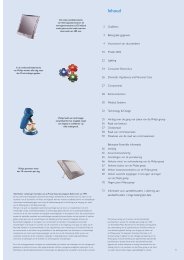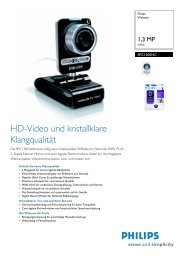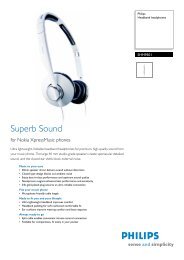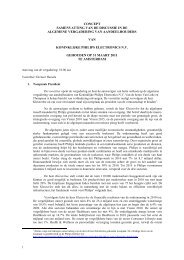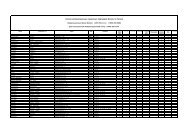Royal Philips Electronics List of Restricted Substances in Products ...
Royal Philips Electronics List of Restricted Substances in Products ...
Royal Philips Electronics List of Restricted Substances in Products ...
You also want an ePaper? Increase the reach of your titles
YUMPU automatically turns print PDFs into web optimized ePapers that Google loves.
CSO-BP01-2006-11<br />
<strong>Royal</strong> <strong>Philips</strong> <strong>Electronics</strong> <strong>List</strong> <strong>of</strong> <strong>Restricted</strong><br />
<strong>Substances</strong> <strong>in</strong> <strong>Products</strong><br />
ROYAL PHILIPS ELECTRONICS<br />
01-01-2007<br />
<strong>Royal</strong> <strong>Philips</strong> <strong>Electronics</strong> <strong>List</strong> <strong>of</strong> <strong>Restricted</strong> <strong>Substances</strong> <strong>in</strong> <strong>Products</strong><br />
Articles (i.e. materials, components, subassemblies, products) delivered to and used <strong>in</strong> <strong>Royal</strong> <strong>Philips</strong> must be free <strong>of</strong> the<br />
"<strong>Restricted</strong> substances" as mentioned <strong>in</strong> this list.<br />
A: <strong>Restricted</strong> <strong>Substances</strong> <strong>in</strong> all applications<br />
<strong>Substances</strong><br />
Restriction Threshold<br />
ppm (mg/kg) 1<br />
Asbestos (all types) 10<br />
Beryllium and Beryllium compounds 1000<br />
Cadmium and Cadmium compounds (<strong>in</strong> plastics) 100 1<br />
Cadmium and Cadmium compounds (<strong>in</strong> metal alloys) (see remark a) 100<br />
Hexavalent Chromium (Cr 6+) and Cr (6+) compounds (see remark b) 1000<br />
Lead and Lead compounds (see remarks b and c) 1000<br />
Lead and lead compounds <strong>in</strong> outer sleeves <strong>of</strong> cables, accord<strong>in</strong>g to Proposition 65<br />
300<br />
legislation, USA<br />
Mercury and Mercury compounds (see remark d) 1000 1<br />
Monomethyl tetrachlorodiphenyl methane (Ugilec 141) 10<br />
Monomethyl dichlorodiphenyl methane (Ugilec 121 or Ugilec 21) 10<br />
Monomethyl dibromodiphenyl methane (DBBT) 10<br />
Ozone deplet<strong>in</strong>g substances (see remark e) 1<br />
Pentachlorophenol (PCP) and its salts and esters 10<br />
Polychlor<strong>in</strong>ated biphenyls (PCBs) 10<br />
Polychlor<strong>in</strong>ated terphenyls (PCTs) 10<br />
Polybrom<strong>in</strong>ated diphenyl ethers (PBDEs) (see remark f) 1000<br />
Polybrom<strong>in</strong>ated biphenyls (PBBs) 1000<br />
a. The restriction does not apply to exemptions <strong>in</strong> European Directive RoHS (2002/95/EC).<br />
b. Does not apply to Medical equipment, which is presently excluded from the EU RoHS Directive. Neither does<br />
it apply to the exemptions <strong>in</strong> EU-RoHS.<br />
c. Lead-based solder<strong>in</strong>g <strong>in</strong> electronic circuit boards and other electric applications is exempted <strong>in</strong> automotive applications<br />
under the European ELV directive (2000/53/EC).<br />
d. Mercury is allowed only <strong>in</strong> gas discharge lamps with certa<strong>in</strong> conditions referred <strong>in</strong> EU RoHS.<br />
e. Ozone deplet<strong>in</strong>g substances, as published <strong>in</strong> 2000 <strong>in</strong> the Montreal protocol on substances that deplete the ozone layer:<br />
CFCs (Chlor<strong>of</strong>luorocarbons), HCFCs (Hydrogenated chlor<strong>of</strong>luorocarbons), Halons, Methyl Bromide, HBFCs<br />
(Hydrobrom<strong>of</strong>luorocarbons), 1,1,1-Trichloroethane, Carbon tetrachloride and bromochloromethane.<br />
f. Polybrom<strong>in</strong>ated diphenylethers (PBDE) are the same as polybrom<strong>in</strong>ated biphenylethers (PBBE); polybrom<strong>in</strong>ated<br />
diphenyloxides (PBDO) are the same as polybrom<strong>in</strong>ated biphenyl oxides (PBBO).<br />
B: Additionally <strong>Restricted</strong> <strong>Substances</strong> <strong>in</strong> product packag<strong>in</strong>g<br />
<strong>Substances</strong> Restriction Threshold<br />
ppm (mg/kg) 1<br />
Arsenic compounds, applied for wood packag<strong>in</strong>g 10<br />
PVC and PVC blends (see remark g) 1000<br />
Sum <strong>of</strong> Heavy metals (Cd, Hg, Cr(6+) and Pb) 100<br />
g. IC pack<strong>in</strong>g is exempted<br />
1 Above this restriction threshold the substance is restricted and declaration <strong>of</strong> the substance is obliged. For Cadmium (<strong>in</strong> plastics only) and Mercury<br />
and their compounds declaration is needed above 50 ppm. In fact, restricted substances are not to be <strong>in</strong>tentionally used, that is, <strong>Royal</strong> <strong>Philips</strong><br />
<strong>Electronics</strong> accepts that certa<strong>in</strong> materials conta<strong>in</strong> a certa<strong>in</strong> amount <strong>of</strong> naturally occurr<strong>in</strong>g restricted substances. Thresholds can represent legal limits, or<br />
refer to currently accepted analys<strong>in</strong>g thresholds. Furthermore these thresholds should be declared on component level. <strong>Substances</strong> are measured <strong>in</strong><br />
homogeneous materials. Exemptions <strong>of</strong> specific applications, mentioned <strong>in</strong> legislation, are also exempted. Nevertheless declaration is still needed.
CSO-BP01-2006-11<br />
<strong>Royal</strong> <strong>Philips</strong> <strong>Electronics</strong> <strong>List</strong> <strong>of</strong> <strong>Restricted</strong><br />
<strong>Substances</strong> <strong>in</strong> <strong>Products</strong><br />
ROYAL PHILIPS ELECTRONICS<br />
01-01-2007<br />
C: Additionally <strong>Restricted</strong> <strong>Substances</strong> when used <strong>in</strong> specific applications<br />
Restriction<br />
<strong>Substances</strong><br />
Threshold<br />
ppm (mg/kg) 1<br />
Remark<br />
Azocolourants 30 Only <strong>in</strong> direct and prolonged sk<strong>in</strong> contact<br />
Tris-(1-azirid<strong>in</strong>yl) phosph<strong>in</strong>oxide 10 applications, when e.g., applied <strong>in</strong> leather and<br />
Tri-(2,3-dibromo-propyl) phosphate 10 textiles<br />
Nickel and nickel alloys (see remark h) 0,5µg/cm2/week<br />
Only <strong>in</strong> direct and prolonged sk<strong>in</strong> contact<br />
applications<br />
Phthalates (see remark h) 1000 Applied <strong>in</strong> toys and childcare articles<br />
Antimony <strong>in</strong> soda lime glass<br />
Arsenic <strong>in</strong> soda lime and borosilicate glass<br />
1000<br />
1000<br />
Only applied <strong>in</strong> lamps<br />
Benzene 5<br />
Chlorobenzene 100 As residue <strong>in</strong> materials<br />
Formaldehyde 0.1<br />
Organic T<strong>in</strong> compounds (TBT, TPT and<br />
TBTO), applied <strong>in</strong> pa<strong>in</strong>ts and as pigments and<br />
Organostannic compounds 1000 as agents for anti-oxidiz<strong>in</strong>g, anti-bacterial,<br />
anti-fungal, anti-septic, anti-sta<strong>in</strong><strong>in</strong>g and antifoul<strong>in</strong>g.<br />
Phenol and phenolic compounds (see remark i)<br />
50 mg/l<br />
Applied <strong>in</strong> toys and childcare articles and<br />
lam<strong>in</strong>ates <strong>of</strong> pr<strong>in</strong>ted wir<strong>in</strong>g boards<br />
Polycyclic aromatic hydrocarbons (PAHs) 50<br />
Applied <strong>in</strong> applications, such as pott<strong>in</strong>g<br />
material for electronic ballast<br />
Polychloronaphtalenes 10 > 3 Cl atoms; applied as stabilizer and flame<br />
retardant <strong>in</strong> plastics<br />
Short-cha<strong>in</strong> chlor<strong>in</strong>ated paraff<strong>in</strong>s 1000<br />
(C10-C13); applied <strong>in</strong> pa<strong>in</strong>ts and as flame<br />
retardant <strong>in</strong> PVC<br />
h. Does not apply to Medical devices and associated equipment. Medical device safety standards require<br />
biocompatibility test<strong>in</strong>g to ensure that chemical substances, which may contact patients dur<strong>in</strong>g use per the<br />
device's <strong>in</strong>tended use, do not pose a health risk, specifically with respect to biocompatibility.<br />
i. CE (Consumer <strong>Electronics</strong>) requirements for phenol <strong>in</strong> lam<strong>in</strong>ates <strong>of</strong> pr<strong>in</strong>ted wir<strong>in</strong>g boards:<br />
• Smell Emission :



